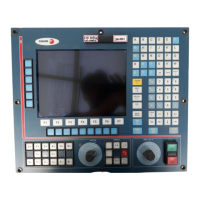
Do you have a question about the Fagor CNC 8055 and is the answer not in the manual?
| Brand | Fagor |
|---|---|
| Model | CNC 8055 |
| Category | Controller |
| Language | English |
Covers creation, editing, and execution of CNC part programs.
Details the various display areas and information shown on the CNC monitor.
Explains the function of different keys and special keystroke sequences.
Describes the components and functions of the CNC operator panel.
Explains how to access and use the CNC's built-in help system.
Details the procedure for loading and installing new software versions.
Describes the role of KeyCF for storing configuration and user programs.
Explains how to access and use a remote hard disk via Ethernet.
Details how to establish communication with a PC using WinDNC software.
Describes accessing the CNC's hard disk from a PC using FTP protocol.
Explains how to search and resume program execution after interruption.
Covers various display modes for monitoring program execution and status.
Explains how to inspect and change tools during program execution.
Details how to use the graphic display for visualizing part programs.
Covers editing new lines or blocks within selected programs.
Explains how to modify the content of a selected program block.
Explains how to delete single blocks or groups of blocks.
Explains how to configure editor settings like autonumbering.
Covers manual axis movement using jog keys.
Explains how to control axis movement using an electronic handwheel.
Describes how to control spindle operation using operator panel keys.
Details how to store and manage axis zero offsets for part programs.
Details tool dimensions, radius, and length wear compensation.
Contains information on cutter angles and geometry for available tools.
Guides on editing various tables like zero offset and tool offset.
Covers accessing and managing programs via directory listing.
Explains how to use the file explorer for program management.
Shows CNC status, last executed line, and error logging.
Covers DNC communication status and control.
Explains how to edit PLC programs, error files, and message files.
Details the process of compiling PLC source programs into executable code.
Covers monitoring PLC programs and resource statuses.
Details how to use the logic analyzer for PLC signal analysis.
Covers managing user symbols and screens (edit, copy, delete).
Explains how to create and modify user screens and symbols.
Details how to insert graphic elements like lines, rectangles, and arcs.
Covers inserting and defining texts within screens and symbols.
Explains how to clear pages or delete graphic elements and texts.
Describes the structure and content of machine parameter tables.
Explains the table for miscellaneous M functions and their setting bits.
Details the tables used for leadscrew error compensation.
Guides on editing and modifying parameter table entries.
Shows system configuration, including hardware and software details.
Explains how to check power supply voltages and internal temperature.
Covers memory, code, and hard disk tests.
Details procedures for axis adjustments like circle geometry and oscilloscope.
Explains direct PC connection via serial or Ethernet.
Details phone call connections for telediagnosis.
Details faster telediagnosis via TCP/IP protocol.
Explains telediagnosis connections via the internet.